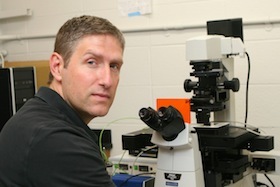Shaw awards go to two UW researchers
One scientist studying how HIV spreads in the body and another examining cellular machinery and its role in disease have earned funding from the Greater Milwaukee Foundation to advance their research.
The University of Wisconsin–Madison’s Nathan Sherer, assistant professor of oncology, and Aaron Hoskins, assistant professor of biochemistry, have each received $200,000 grants through the foundation’s competitive Shaw Scientist Program.

Nathan Sherer
The annual award supports emerging investigators with innovative ideas in biochemistry, biological sciences and cancer research. Such unrestricted funding is critical for young researchers working to establish their labs and develop early data that will allow them to compete for larger, National Institutes of Health grants.
Sherer is interested in understanding how viral infections spread from cell to cell. His laboratory’s emphasis is on HIV, the virus that causes AIDS and infects more than 35 million people worldwide, resulting in about 1.5 million deaths each year.
“There is no vaccine or cure for long-term, persistent infection,” Sherer said. “While combined antiviral therapy can reduce viral load and delay progression to AIDS, these drugs are expensive, have costly side effects and can drive the evolution of drug- resistant viruses. Identifying new viral and cellular targets leading to the development of better therapies remains a crucial goal for the field.”
With funding from the Shaw Scientist Award, Sherer will further characterize the process by which infected cells form tight contacts with uninfected cells, making virus production and proliferation more efficient. Long term, he hopes this research will lead to ideas for interrupting this process and the development of drugs effective against HIV as well as new broad-spectrum antiviral medications.
Sherer earned a bachelor of arts from Grinnell College, Iowa, and a Ph.D. in microbiology from Yale University. His post-doctoral training took place at King’s College London School of Medicine.
Aaron Hoskins
Hoskins studies the cellular machines that interpret the information found in DNA genes and put it in a form that can be used by the cell. His research team focuses primarily on a machine called the spliceosome, which is made from more than 100 different pieces.
“We use cutting-edge microscopes to study how all of those different pieces come together to build a working spliceosome machine,” Hoskins said. “In the long term, we would like to study how these machines are built in living cells and how errors in their construction can lead to diseases like blindness or muscular atrophies.”
The Shaw Scientist Award will enable Hoskins to pursue “high-risk, high-reward” projects vital to understanding how cellular machines are built. The funding will also help Hoskins accommodate undergraduates seeking summer research opportunities in his lab, he said.
Hoskins graduated from Purdue University with a bachelor of science and earned his Ph.D. at Massachusetts Institute of Technology. He completed fellowship training at Brandeis University and University of Massachusetts Medical School.
“Dorothy Shaw, this award’s namesake, was passionate about innovation in research,” said Ellen Gilligan, president and CEO of the Greater Milwaukee Foundation. “I suspect she would be very impressed by this year’s award recipients but not at all surprised by the caliber of their work, as her intent from the beginning was to advance the boundaries of science.”
The Shaw Scientist Awards started in 1982 thanks to a $4.3 million bequest from Dorothy Shaw, widow of James Shaw, a prominent Milwaukee attorney. In addition to $2 million in special grants, Shaw’s fund has awarded more than $12.5 million in grants to 65 scientists from UW–Madison and UW-Milwaukee during the past three decades. An advisory panel with scientists representing major U.S. research institutions selects the winners.
The Shaw awards are administered by the Greater Milwaukee Foundation, is a family of more than 1,200 individual charitable funds created by donors to serve the local charitable causes of their choice. Started in 1915, the foundation is one of the oldest and largest community foundations in the world.




